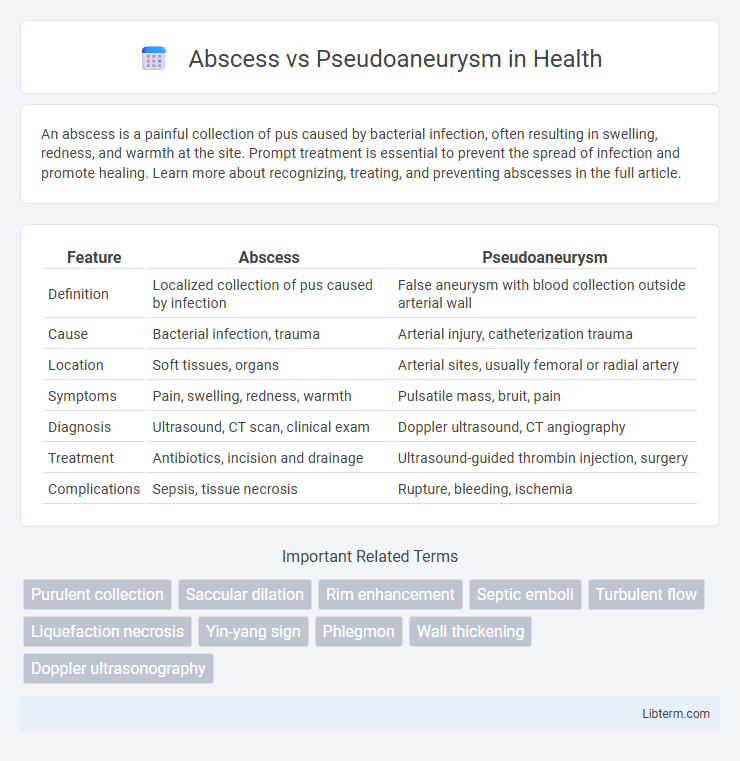An abscess is a painful collection of pus caused by bacterial infection, often resulting in swelling, redness, and warmth at the site. Prompt treatment is essential to prevent the spread of infection and promote healing. Learn more about recognizing, treating, and preventing abscesses in the full article.
Table of Comparison
| Feature | Abscess | Pseudoaneurysm |
|---|---|---|
| Definition | Localized collection of pus caused by infection | False aneurysm with blood collection outside arterial wall |
| Cause | Bacterial infection, trauma | Arterial injury, catheterization trauma |
| Location | Soft tissues, organs | Arterial sites, usually femoral or radial artery |
| Symptoms | Pain, swelling, redness, warmth | Pulsatile mass, bruit, pain |
| Diagnosis | Ultrasound, CT scan, clinical exam | Doppler ultrasound, CT angiography |
| Treatment | Antibiotics, incision and drainage | Ultrasound-guided thrombin injection, surgery |
| Complications | Sepsis, tissue necrosis | Rupture, bleeding, ischemia |
Introduction to Abscess and Pseudoaneurysm
An abscess is a localized collection of pus caused by infection and characterized by inflammation, swelling, and pain, often requiring drainage for resolution. A pseudoaneurysm, or false aneurysm, occurs when blood leaks from an arterial rupture into surrounding tissues, forming a contained hematoma that pulsates due to arterial pressure. Both conditions present with localized masses but differ in etiology, with abscesses resulting from infectious processes and pseudoaneurysms from vascular injury or trauma.
Definition of Abscess
An abscess is a localized collection of pus within tissue caused by a bacterial infection, leading to inflammation and swelling. It often presents as a painful, tender, and warm mass, typically requiring drainage and antibiotic therapy for resolution. Unlike a pseudoaneurysm, which involves blood vessel wall injury and blood leakage, an abscess is purely an infectious process without vascular involvement.
Definition of Pseudoaneurysm
A pseudoaneurysm, also known as a false aneurysm, is a hematoma that forms when blood escapes from a damaged arterial wall but is contained by the surrounding tissues, creating a pulsatile sac. Unlike a true aneurysm, a pseudoaneurysm does not involve all layers of the arterial wall, resulting in an unstable structure prone to rupture. This condition often arises after vascular injury, catheterization, or trauma and requires accurate diagnosis to differentiate from abscesses, which are localized collections of pus caused by infection.
Causes and Risk Factors
Abscesses commonly result from bacterial infections, with Staphylococcus aureus and Streptococcus species being prevalent pathogens, and risk factors include immunosuppression, diabetes, and poor hygiene. Pseudoaneurysms typically arise due to vascular injury from trauma, surgical procedures, or catheterization, with risk factors such as anticoagulation therapy, arterial wall weakness, and repeated arterial punctures. Understanding these distinctive causes and risk profiles is essential for accurate diagnosis and targeted treatment.
Clinical Manifestations
Abscesses typically present with localized pain, swelling, erythema, and tenderness, often accompanied by fever and systemic signs of infection. Pseudoaneurysms manifest as a pulsatile mass with a bruit on auscultation and may cause localized pain or neurological symptoms due to compression of adjacent structures. Clinical differentiation relies on these characteristic signs, with abscesses showing infectious symptoms and pseudoaneurysms exhibiting vascular features.
Diagnostic Modalities
Diagnostic modalities for abscess primarily include ultrasound and computed tomography (CT) scans, which effectively identify fluid collections and surrounding inflammation. In contrast, pseudoaneurysms are best diagnosed using Doppler ultrasound to detect turbulent blood flow and CT angiography for precise vascular anatomy and rupture risk assessment. Magnetic resonance imaging (MRI) can also assist in differentiation by highlighting soft tissue characteristics specific to abscesses or vascular anomalies in pseudoaneurysms.
Key Differences in Imaging
Abscesses typically appear on imaging as well-defined fluid collections with peripheral rim enhancement on CT or MRI, often accompanied by surrounding inflammatory changes such as fat stranding. Pseudoaneurysms present as contrast-filled sacs outside the arterial lumen on angiography or CT angiography, showing a characteristic "yin-yang" flow pattern on Doppler ultrasound, indicating turbulent blood flow. Unlike abscesses, pseudoaneurysms lack an inflammatory capsule and require vascular imaging modalities for accurate diagnosis.
Treatment Approaches
Treatment of an abscess primarily involves prompt incision and drainage combined with antibiotic therapy to eradicate infection and prevent systemic spread. Pseudoaneurysm management often requires ultrasound-guided thrombin injection or endovascular techniques such as coil embolization to seal the arterial breach and restore vascular integrity. Surgical intervention is reserved for complex abscesses with extensive necrosis or pseudoaneurysms at risk of rupture or failure of minimally invasive treatments.
Complications and Prognosis
Abscesses can lead to serious complications such as sepsis, tissue necrosis, and systemic infection if untreated, often requiring surgical drainage for resolution; prognosis is generally favorable with timely intervention but can worsen with delayed treatment. Pseudoaneurysms pose risks of rupture, hemorrhage, and thromboembolism, necessitating prompt diagnosis and endovascular or surgical repair to prevent life-threatening outcomes. Prognosis of pseudoaneurysms depends on size, location, and promptness of intervention, with smaller lesions often managed conservatively and larger or symptomatic ones requiring urgent treatment.
Summary: Abscess vs Pseudoaneurysm
An abscess is a localized collection of pus caused by infection, characterized by swelling, pain, and redness, often requiring drainage and antibiotics for treatment. A pseudoaneurysm involves a breach in the arterial wall leading to a contained blood leak, presenting as a pulsatile mass and diagnosed via ultrasound or CT angiography. Differentiating these conditions is critical, as abscesses demand infection management, while pseudoaneurysms require vascular intervention to prevent rupture.
Abscess Infographic

 libterm.com
libterm.com